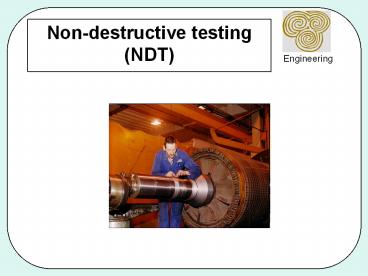Non-destructive testing (NDT) - PowerPoint PPT Presentation
Title:
Non-destructive testing (NDT)
Description:
Non-destructive testing (NDT) Why use NDT? Components are not destroyed Can test for internal flaws Useful for valuable components Can test components that are in use ... – PowerPoint PPT presentation
Number of Views:2094
Avg rating:3.0/5.0
Title: Non-destructive testing (NDT)
1
Non-destructive testing (NDT)
2
Why use NDT?
- Components are not destroyed
- Can test for internal flaws
- Useful for valuable components
- Can test components that are in use
3
Penetrant testing
- Used for surface flaws.
- The oil and chalk test is a traditional version
of this type of testing. Coloured dyes are now
used.
4
(No Transcript)
5
Magnetic particle testing
- Used for ferrous metals.
- Detects flaws close to the surface of the
material. - The component to be tested must first be
magnetized. - Magnetic particles which can be dry or in
solution are sprinkled onto the test piece. - The particles stick to the magnetic field and
flaws can be inspected visually by examining the
pattern to see if it has been distorted. - The component must be demagnetized after testing.
6
(No Transcript)
7
(No Transcript)
8
Eddy current testing
- Used for non-ferrous metals
- A.C. current is passed through the coil.
- The test piece is passed under the coil causing
secondary currents called eddy currents to flow
through the test piece. This causes a magnetic
field to flow in the test piece. - The flaws are detected on an oscilloscope by
measuring a change in the magnetic field.
9
(No Transcript)
10
(No Transcript)
11
(No Transcript)
12
(No Transcript)
13
Ultrasonic testing
- Ultrasonic Sound waves are bounced off the
component and back to a receiver. If there is a
change in the time taken for the wave to return
this will show a flaw. This is similar to the
operation of a sonar on a ship. - Operation.
- The ultrasonic probe sends the sound wave through
the piece. - The sound wave bounces of the piece and returns.
- The results are then placed on the display screen
in the form of peaks. - Where the peaks fluctuate this will show a fault
in the piece. - Uses.
- This is generally used to find internal flaws in
large forgings, castings and in weld inspections.
14
(No Transcript)
15
(No Transcript)
16
Radiography (X-ray) Testing
- The x-ray are released by heating the cathode.
- They are then accelerated by the D.C. current and
directed onto the piece by the tungsten anode. - The x-rays then pass through the test piece onto
an x-ray film which displays the results. - The x-rays cannot pass through the faults as
easily making them visible on the x-ray film. - Uses.
- This is a test generally used to find internal
flaws in materials. It is used to check the
quality of welds, for example, to find voids or
cracks.
17
(No Transcript)
18
(No Transcript)































